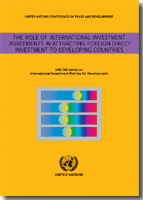Yellow Series: The Role of IIAs in Attracting FDI to Developing Countries
International investment agreements (IIAs) are a key instrument in the strategies of most countries, in particular developing countries, to attract foreign investment. Accordingly, policymakers need to know what role these treaties actually play and to what extent they can contribute to receiving more investment from abroad. Equally important is the question of whether the impact of IIAs on investment inflows also depends on the specific type of investment treaty concluded. A better understanding can help prepare the ground for more effective systemic host country policies that give IIAs their proper place in an overall strategy of attracting foreign investment and making it work for development.
The paper starts with a brief summary of the main host country determinants for foreign direct investment (FDI). They consist of:
a. the general policy framework for foreign investment, including economic, political and social stability, and the legislation affecting foreign investment;
b. economic determinants, such as the market size, cost of resources and other inputs (e.g. costs of labour) or the availability of natural resources; and
c. business facilitation, such as investment promotion including investment incentives.
All three determinants interact, enhancing or reducing the attractiveness of countries for foreign investment.
IIAs are part of the policy framework for foreign investment, and are thus only one of the many factors that impact on a company´s decision where to make an investment. As a consequence - and this is one of the key messages of this study - IIAs alone can never be a sufficient policy instrument to attract FDI. Other host country determinants, in particular the economic determinants, play a more powerful role.
Against this background, the paper reviews a number of econometric studies that explore the impact of IIAs on investment inflows. It groups the different studies according to the type of IIAs they analyse: bilateral investment treaties (BITs) on the one hand, and various kinds of broader economic cooperation agreements on the other. With regard to both types of agreements, the study reviews the findings of numerous econometric studies and, based on this analysis, then arrives at its own conclusions. It makes the point that - within their limited role as foreign investment determinants - IIAs can influence a company´s decision where to invest, and this impact is generally stronger in the case of preferential trade and investment agreements than with regard to BITs.
Overall, developing countries stand to benefit from engaging in IIAs in terms of increasing their attractiveness for FDI, and therefore the likelihood that they receive more FDI. However, - and this point cannot be emphasized enough - the conclusion of IIAs needs to be embedded in broader FDI policies covering all host country determinants of foreign investment. IIAs alone cannot do the job. Nonetheless, consideration could be given to further strengthen the role of IIAs as an investment promotion instrument. For the time being, IIAs do not contain commitments by capital-exporting countries other than vague language relating to investment promotion and mostly promote foreign investment only indirectly through the granting of investment protection. However, policymakers may wish to consider developing IIAs with effective and operational provisions on investment promotion, aimed at attracting high-quality FDI and maximizing attendant development contributions.
















